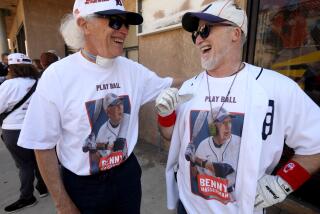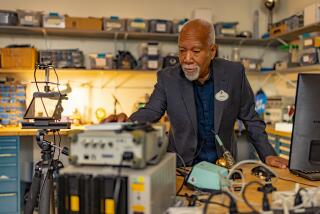Walter Fredrick Morrison dies at 90; father of the Frisbee
Walter Fredrick Morrison, whose post-World War II invention of a “flying” plastic disc became an American recreational icon known as the Frisbee, has died. He was 90.
Morrison died Tuesday of age-related causes at his home in Monroe, Utah, said his son, Walt.
Wham-O Inc. has sold more than 200 million Frisbees since Morrison sold the company the rights to what he called the Pluto Platter in 1957.
“Fred’s timeless contribution to the sport and toy industries has brought smiles to well over 200 million faces and continues to do so every day,” Kevin Martzolff, Wham-O’s vice president of design & marketing, said in a statement. “We are forever thankful for his invention of the Frisbee Disc and his ongoing partnership with Wham-O for over 50 years.”
Morrison was born Jan. 23, 1920, in Richfield, Utah, and moved to California at age 11. In 1937, he and his girlfriend and future wife, Lucile, began tossing a large popcorn can lid back and forth for fun during a Thanksgiving party.
When the lid got banged up, they switched to cake pans, which they discovered flew much better.
A year later, they were tossing a cake pan to each other on the beach in Santa Monica when someone saw them and offered a quarter for the pan.
“That got the wheels turning, because you could buy a cake pan for 5 cents, and if people on the beach were willing to pay a quarter for it, well, there was a business,” Morrison told the Virginia-Pilot in 2007.
Soon, they were regularly selling cake pans on the beach for a quarter.
They continued their modest enterprise after marrying in 1939 and on up to World War II, when Morrison served in the Army Air Forces as a P-47 pilot in Europe, where he spent time as a prisoner of war.
Back home in 1946, Morrison sketched a design for an aerodynamically improved flying disc he dubbed the Whirlo-Way.
In 1948, after modifying his drawings and experimenting with a number of prototypes, Morrison and an early partner, Warren Franscioni, began producing the first plastic discs that -- in the wake of reported UFO sightings -- were now called Flyin-Saucers.
“We worked fairs, demonstrating it,” Morrison told the Virginian-Pilot. “That’s where we learned we could sell these things, because people ate them up.”
In 1955, after further improvement of his design, Morrison began producing a new disc, which he called the Pluto Platter.
After Morrison sold the rights to Wham-O in 1957, the company named the disc the Frisbee.
“I thought the name was a horror. Terrible,” he told the Press-Enterprise of Riverside in 2007.
But Morrison, who told Forbes magazine in 1982 that by then he had received about $2 million in royalty payments, later changed his mind. “I wouldn’t change the name of it for the world,” he said.
A 1964 redesign by Wham-O employee Ed Headrick added grooves to the top of the Frisbee’s surface that improved the disc’s flight.
The company then began marketing the Frisbee as a sports product, spurring the creation of Frisbee golf and the team sport known as ultimate Frisbee.
A longtime carpenter who also spent time as a Los Angeles building inspector, Morrison later raised and raced quarter horses as a hobby on his Utah property.
Asked the secret to the perfect Frisbee throw, Morrison told the Press-Enterprise in 2007 that it was “all in the wrist.”
“A good throw takes practice,” he said. “You need a good, firm grip and a quick release.”
But, he conceded, “the darn things can be unpredictable.”
Morrison was preceded in death by his wife. In addition to his son Walt, he is survived by his daughters, Judy and Christie; and four grandchildren.
More to Read
Start your day right
Sign up for Essential California for the L.A. Times biggest news, features and recommendations in your inbox six days a week.
You may occasionally receive promotional content from the Los Angeles Times.






